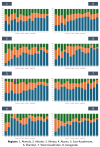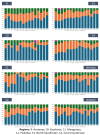Trends in Stage-Specific Kidney Cancer Incidence in Kazakhstan, 2005-2019
- PMID: 39342603
- PMCID: PMC11700335
- DOI: 10.31557/APJCP.2024.25.9.3239
Trends in Stage-Specific Kidney Cancer Incidence in Kazakhstan, 2005-2019
Abstract
Objective: The aim is to analyze the incidence of kidney cancer over a 15-year period, considering factors such as stage, age, sex, and morphological verification in the regional context in Kazakhstan.
Methods: The retrospective study was done using descriptive and analytical methods of oncoepidemiology. The extensive, crude and age-specific incidence rates are determined according to the generally accepted methodology used in sanitary statistics. The data were used to calculate the average percentage change (APС) using the Joinpoint regression analysis to determine the trend over the study period.
Results: Among the meticulously documented 15,277 cases, a conspicuous male predominance was noted, comprising 53.7% of cases compared to 46.3% in females, with peak incidences observed within the 50-69 age cohorts. The average age at diagnosis exhibited a progressive rise over the study period, with discernible variations observed in age-specific incidence rates, particularly pronounced within the 60-84 age brackets. Noteworthy temporal trends indicated a consistent uptick in crude incidence rates, with distinct regional disparities manifesting higher rates in northern regions relative to their southern and western counterparts. Stratification by cancer stage unveiled a significant surge in stages I-II cases alongside a concomitant decrement in stage III incidences, complemented by reductions in stage IV occurrences and instances of unspecified disease stages. Morphological verification rates displayed regional variations, with an overarching ascending trajectory across most regions, albeit exceptions noted, notably in the Kyzylorda region.
Conclusion: Our study identified a rise in kidney cancer incidence in Kazakhstan, likely reflecting global trends driven by increased risk factor exposure and incidental imaging findings. Regional disparities and varied stage distributions highlight the complexity of kidney cancer epidemiology. Despite advancements in early detection, delayed diagnosis persists, necessitating improved surveillance and diagnostic practices.
Keywords: Dynamics; cancer rate; morphological verification; regions; renal cancer.
Conflict of interest statement
The authors declare that there is no conflict of interest.
Figures





Similar articles
-
Liver Cancer Incidence in Kazakhstan: Fifteen-Year Retrospective Study.Asian Pac J Cancer Prev. 2024 May 1;25(5):1763-1775. doi: 10.31557/APJCP.2024.25.5.1763. Asian Pac J Cancer Prev. 2024. PMID: 38809649 Free PMC article.
-
Epidemiology of Lung Cancer in Kazakhstan: Trends and Geographic Distribution.Asian Pac J Cancer Prev. 2023 May 1;24(5):1521-1532. doi: 10.31557/APJCP.2023.24.5.1521. Asian Pac J Cancer Prev. 2023. PMID: 37247271 Free PMC article.
-
Lymphosarcoma Incidence in Kazakhstan: A Retrospective Survey (2010-2019).Asian Pac J Cancer Prev. 2023 Jun 1;24(6):1885-1896. doi: 10.31557/APJCP.2023.24.6.1885. Asian Pac J Cancer Prev. 2023. PMID: 37378916 Free PMC article.
-
Unraveling the global burden of inflammatory bowel disease (1990-2019): A Joinpoint regression analysis of divergent trends in 10-24 and 50-69 age cohorts.Autoimmun Rev. 2024 Jun;23(6):103586. doi: 10.1016/j.autrev.2024.103586. Epub 2024 Jul 30. Autoimmun Rev. 2024. PMID: 39084279 Review.
-
Cancer of the Larynx-20-Year Comparative Survival and Mortality Analysis by Age, Sex, Race, Stage, Grade, Cohort Entry Time-Period, Disease Duration and ICD-O-3 Topographic Primary Sites-Codes C32.0-9: A Systematic Review of 43,103 Cases for Diagnosis Years 1975-2017: (NCI SEER*Stat 8.3.9).J Insur Med. 2024 Jul 1;51(2):92-110. doi: 10.17849/insm-51-2-92-110.1. J Insur Med. 2024. PMID: 39266004
References
-
- Ferlay J, Ervik M, Lam F, Laversanne M, Colombet M, Mery L. Global cancer observatory: Cancer today (version 1 1) Lyon: france: International agency for research on cancer;
-
- Znaor A, Lortet-Tieulent J, Laversanne M, Jemal A, Bray F. International variations and trends in renal cell carcinoma incidence and mortality. Eur Urol. 2015;67(3):519–30. - PubMed
-
- Capitanio U, Montorsi F. Renal cancer. Lancet. 2016;387(10021):894–906. - PubMed
MeSH terms
LinkOut - more resources
Full Text Sources
Medical

